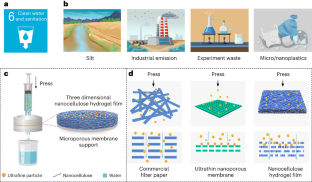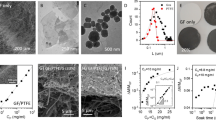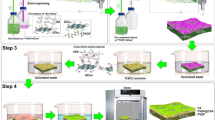Abstract
Removal of suspended solids (SS) is a prerequisite for delivering clean water. However, removal of ultrafine SS during water purification in a cost-effective manner remains a global challenge. Here we develop an injection-driven filter system that integrates a fully bio-based biodegradable nanofibre hydrogel film with a syringe to remove ultrafine SS for portable and sustainable water purification. The hydrogel film features a densely stacked and entangled nanofibre network, enabling it to reject ultrafine SS with a cut-off size of ∼10 nm at a ∼100% rejection efficiency, greatly surpassing commercial filter papers and microporous membranes. During operation, the flux of the injection-driven filter system reaches 90.6 g cm−2 h−1, which is 7.2 times higher than that of commercial polycarbonate ultrafiltration membrane operated under the same conditions. Moreover, this filter system demonstrates good scalability and reusability, with low cost and reduced environmental footprint. The versatility of this filter system is further proven by successful clean water production from various difficult-to-purify water resources, including muddy water, river water, dirty water from melted snow and nanoplastic-contaminated water. Overall, this work provides a facile yet cost-effective tool for sustainable water purification.
This is a preview of subscription content, access via your institution
Access options
Access Nature and 54 other Nature Portfolio journals
Get Nature+, our best-value online-access subscription
$29.99 / 30 days
cancel any time
Subscribe to this journal
Receive 12 digital issues and online access to articles
$119.00 per year
only $9.92 per issue
Buy this article
- Purchase on Springer Link
- Instant access to full article PDF
Prices may be subject to local taxes which are calculated during checkout





Similar content being viewed by others
Data availability
All data needed to evaluate the conclusions in the paper are present in the paper and/or the Supplementary Information. Source data are provided with this paper.
References
Vörösmarty, C. J., Green, P., Salisbury, J. & Lammers, R. B. Global water resources: vulnerability from climate change and population growth. Science 289, 284–288 (2000).
Zhou, X., Guo, Y., Zhao, F. & Yu, G. Hydrogels as an emerging material platform for solar water purification. Acc. Chem. Res. 52, 3244–3253 (2019).
Zhao, F., Guo, Y., Zhou, X., Shi, W. & Yu, G. Materials for solar-powered water evaporation. Nat. Rev. Mater. 5, 388–401 (2020).
Johnson, N., Revenga, C. & Echeverria, J. Managing water for people and nature. Science 292, 1071–1072 (2001).
Sadoff, C. W., Borgomeo, E. & Uhlenbrook, S. Rethinking water for SDG 6. Nat. Sustain. 3, 346–347 (2020).
Sachs, J. D. et al. Six transformations to achieve the sustainable development goals. Nat. Sustain. 2, 805–814 (2019).
Jin, M. et al. Underwater oil capture by a three‐dimensional network architectured organosilane surface. Adv. Mater. 23, 2861–2864 (2011).
Lu, F. & Astruc, D. Nanocatalysts and other nanomaterials for water remediation from organic pollutants. Coord. Chem. Rev. 408, 213180 (2020).
Barac, T. et al. Engineered endophytic bacteria improve phytoremediation of water-soluble, volatile, organic pollutants. Nat. Biotechnol. 22, 583–588 (2004).
Mitrano, D. M., Wick, P. & Nowack, B. Placing nanoplastics in the context of global plastic pollution. Nat. Nanotechnol. 16, 491–500 (2021).
Zhou, J., Hung, Y.-C. & Xie, X. Making waves: pathogen inactivation by electric field treatment: from liquid food to drinking water. Water Res. 207, 117817 (2021).
Shannon, M. A. et al. Science and technology for water purification in the coming decades. Nature 452, 301–310 (2008).
Zhou, J., Yang, F., Huang, Y., Ding, W. & Xie, X. Smartphone-powered efficient water disinfection at the point of use. npj Clean Water 3, 40 (2020).
Woodward, J., Li, J., Rothwell, J. & Hurley, R. Acute riverine microplastic contamination due to avoidable releases of untreated wastewater. Nat. Sustain. 4, 793–802 (2021).
Vethaak, A. D. & Legler, J. Microplastics and human health. Science 371, 672–674 (2021).
Ali, I. & Gupta, V. Advances in water treatment by adsorption technology. Nat. Protoc. 1, 2661–2667 (2006).
Wang, T., Yu, C. & Xie, X. Microfluidics for environmental applications. Microfluidics Biotechnol. 179, 267–290 (2020).
Luo, L. & Nguyen, A. V. A review of principles and applications of magnetic flocculation to separate ultrafine magnetic particles. Sep. Purif. Technol. 172, 85–99 (2017).
Akbulut, O. et al. Separation of nanoparticles in aqueous multiphase systems through centrifugation. Nano Lett. 12, 4060–4064 (2012).
Liang, H. W. et al. Robust and highly efficient free‐standing carbonaceous nanofiber membranes for water purification. Adv. Funct. Mater. 21, 3851–3858 (2011).
Metreveli, G. et al. A size‐exclusion nanocellulose filter paper for virus removal. Adv. Healthc. Mater. 3, 1546–1550 (2014).
An, A. K. et al. PDMS/PVDF hybrid electrospun membrane with superhydrophobic property and drop impact dynamics for dyeing wastewater treatment using membrane distillation. J. Membr. Sci. 525, 57–67 (2017).
Liu, T., Zhou, H., Graham, N., Yu, W. & Sun, K. 2D kaolin ultrafiltration membrane with ultrahigh flux for water purification. Water Res. 156, 425–433 (2019).
Mohammad, A. W. et al. Nanofiltration membranes review: recent advances and future prospects. Desalination 356, 226–254 (2015).
Moon, R. J., Martini, A., Nairn, J., Simonsen, J. & Youngblood, J. Cellulose nanomaterials review: structure, properties and nanocomposites. Chem. Soc. Rev. 40, 3941–3994 (2011).
Ling, S., Kaplan, D. L. & Buehler, M. J. Nanofibrils in nature and materials engineering. Nat. Rev. Mater. 3, 18016 (2018).
Huang, W., Ling, S., Li, C., Omenetto, F. G. & Kaplan, D. L. Silkworm silk-based materials and devices generated using bio-nanotechnology. Chem. Soc. Rev. 47, 6486–6504 (2018).
Palika, A. et al. An antiviral trap made of protein nanofibrils and iron oxyhydroxide nanoparticles. Nat. Nanotechnol. 16, 918–925 (2021).
Gustafsson, S. et al. Mille-feuille paper: a novel type of filter architecture for advanced virus separation applications. Mater. Horiz. 3, 320–327 (2016).
Gustafsson, S. & Mihranyan, A. Strategies for tailoring the pore-size distribution of virus retention filter papers. ACS Appl. Mater. Interfaces 8, 13759–13767 (2016).
Wang, Y. et al. Wood‐derived nanofibrillated cellulose hydrogel filters for fast and efficient separation of nanoparticles. Adv. Sustain. Syst. 3, 1900063 (2019).
Ling, S., Jin, K., Kaplan, D. L. & Buehler, M. J. Ultrathin free-standing Bombyx mori silk nanofibril membranes. Nano Lett. 16, 3795–3800 (2016).
Ling, S. et al. Design and function of biomimetic multilayer water purification membranes. Sci. Adv. 3, e1601939 (2017).
Hua, M. et al. Strong tough hydrogels via the synergy of freeze-casting and salting out. Nature 590, 594–599 (2021).
Zhang, Y.-Z. et al. MXene hydrogels: fundamentals and applications. Chem. Soc. Rev. 49, 7229–7251 (2020).
Lei, C. et al. Polyzwitterionic hydrogels for efficient atmospheric water harvesting. Angew. Chem. Int. Ed. 134, e202200271 (2022).
Wu, S. et al. Poly (vinyl alcohol) hydrogels with broad‐range tunable mechanical properties via the Hofmeister effect. Adv. Mater. 33, 2007829 (2021).
Su, L. et al. Dilution-induced gel-sol-gel-sol transitions by competitive supramolecular pathways in water. Science 377, 213–218 (2022).
Zhang, Y.-Z. et al. MXenes stretch hydrogel sensor performance to new limits. Sci. Adv. 4, eaat0098 (2018).
Wang, X. et al. Mechanical nonreciprocity in a uniform composite material. Science 380, 192–198 (2023).
Kim, J. H., Lee, D., Lee, Y. H., Chen, W. & Lee, S. Y. Nanocellulose for energy storage systems: beyond the limits of synthetic materials. Adv. Mater. 31, 1804826 (2019).
Chen, W. et al. Nanocellulose: a promising nanomaterial for advanced electrochemical energy storage. Chem. Soc. Rev. 47, 2837–2872 (2018).
Griggs, D. et al. Sustainable development goals for people and planet. Nature 495, 305–307 (2013).
Shen, S. et al. Computational design and manufacturing of sustainable materials through first-principles and materiomics. Chem. Rev. 123, 2242–2275 (2023).
Ling, S. et al. Combining in silico design and biomimetic assembly: a new approach for developing high-performance dynamic responsive bio-nanomaterials. Adv. Mater. 30, 1802306 (2018).
Yu, C.-H., Qin, Z. & Buehler, M. J. Artificial intelligence design algorithm for nanocomposites optimized for shear crack resistance. Nano Futures 3, 035001 (2019).
Guo, K., Yang, Z., Yu, C.-H. & Buehler, M. J. Artificial intelligence and machine learning in design of mechanical materials. Mater. Horiz. 8, 1153–1172 (2021).
Chen, W. et al. Individualization of cellulose nanofibers from wood using high-intensity ultrasonication combined with chemical pretreatments. Carbohydr. Polym. 83, 1804–1811 (2011).
Chen, W. et al. Comparative study of aerogels obtained from differently prepared nanocellulose fibers. ChemSusChem 7, 154–161 (2014).
Ministry of Health of the People’s Republic of China & Standardization Administration of China. Standard examination methods for drinking water–microbiological parameters (GB/T 5750.12-2006). Standards Press of China https://std.samr.gov.cn/gb/search/gbDetailed?id=71F772D77E7ED3A7E05397BE0A0AB82A (2006).
Ministry of Health of the People’s Republic of China & Standardization Administration of China. Standard examination methods for drinking water–organoleptic and physical parameters (GB/T 5750.4-2006). Standards Press of China https://std.samr.gov.cn/gb/search/gbDetailed?id=71F772D7C731D3A7E05397BE0A0AB82A (2006).
Ministry of Health of the People’s Republic of China & Standardization Administration of China. Standard examination methods for drinking water–aggregate organic parameters (GB/T 5750.7-2006). Standards Press of China https://std.samr.gov.cn/gb/search/gbDetailed?id=71F772D7F6DBD3A7E05397BE0A0AB82A (2006).
Ministry of Health of the People’s Republic of China & Standardization Administration of China. Standard examination methods for drinking water–nonmetal parameters (GB/T 5750.5-2006). Standards Press of China https://std.samr.gov.cn/gb/search/gbDetailed?id=71F772D75AC6D3A7E05397BE0A0AB82A (2006).
Acknowledgements
W.C. acknowledges support from the National Natural Science Foundation of China (No. 31922056) and the Fundamental Research Funds for the Central Universities (No. 2572021CG01). G.Y. acknowledges support from the Welch Foundation F-1861, Norman Hackerman Award in Chemical Research and Camille Dreyfus Teacher-Scholar Award.
Author information
Authors and Affiliations
Contributions
W.C. and G.Y. conceived the idea and directed the project. M.J. and C.J. performed most of the experiments. C.L. participated in most data and mechanism analysis. X.H. and Q.L. participated in the nanoparticle filtration experiments. Y.W., S. Ling and Y.Z. participated in the analysis of the filtration mechanism. H.Y., S. Liu and J.L. commented on the paper. W.C. and G.Y. wrote the paper. All authors agreed with the final version of the paper.
Corresponding authors
Ethics declarations
Competing interests
The authors declare no competing interests.
Peer review
Peer review information
Nature Sustainability thanks the anonymous reviewers for their contribution to the peer review of this work.
Additional information
Publisher’s note Springer Nature remains neutral with regard to jurisdictional claims in published maps and institutional affiliations.
Supplementary information
Supplementary Information
Supplementary Tables 1 and 2 and Figs. 1–30.
Supplementary Video 1
The appearance of a BNHF shows that it is a very convenient filter.
Supplementary Video 2
X-ray micro-CT investigation revealing the three-dimensional structure of HF-5-10 on a microporous membrane.
Source data
Source Data Fig. 3
Unprocessed UV–vis spectra data of the feed and filtrate of 30∼50 nm TiO2 nanoparticle water dispersion filtered through a microporous membrane or an HF-5-10 by manual pressure. Unprocessed UV–vis spectra data of the feed and filtrate of 20∼80 nm ATO nanoparticle water dispersion filtered through a G-HF-40-15 by manual pressure.
Source Data Fig. 4
Unprocessed UV–vis spectra data of the feed and filtrate of soil-contaminated water and dirty snow water filtered through an HF-5-10. Unprocessed UV–vis spectra data of two times filtration of 30 nm polystyrene nanoplastic water dispersions with different concentrations filtered through an HF-10-15. Unprocessed UV–vis spectra data of the feed and filtrate of dirty river water filtered through an HF-5-1000.
Rights and permissions
Springer Nature or its licensor (e.g. a society or other partner) holds exclusive rights to this article under a publishing agreement with the author(s) or other rightsholder(s); author self-archiving of the accepted manuscript version of this article is solely governed by the terms of such publishing agreement and applicable law.
About this article
Cite this article
Jiang, M., Jing, C., Lei, C. et al. A bio-based nanofibre hydrogel filter for sustainable water purification. Nat Sustain 7, 168–178 (2024). https://doi.org/10.1038/s41893-023-01264-9
Received:
Accepted:
Published:
Issue Date:
DOI: https://doi.org/10.1038/s41893-023-01264-9
This article is cited by
-
Filtration made green and easy
Nature Sustainability (2024)



